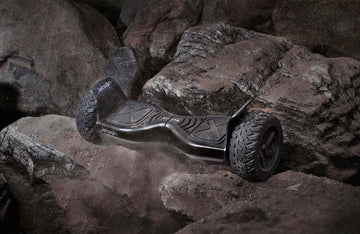Witness the everyday hoverboard: whizzing past pedestrians with ease, turning on a dime, reversing direction in an instant, all in near silence while carrying up to 230 pounds of a human being.
Wait — did we just say “everyday hoverboard?” How did we get so casual about something so incredible? How does this amazing thing we take for granted even work in the first place?
We’re going to describe some of the inner workings of this modern wonder and, hopefully, demystify it a bit.
Wheels in Motion
Most functions of the hoverboard are in the wheels.
Each wheel contains a full electric motor. That motor is incorporated into the structure of the wheel itself. Thus, hoverboards give new meaning to the term “direct drive.” The wheel rims are rotors of electric motors: no transmission or gears needed.
Of course, those wheels do more than propel the hoverboard down your chosen path. Inside each are speed and tilt sensors. That speed and tilt information is critical to making the hoverboard work like a wheeled attachment to a human body. With special features like Jetson’s Active Balance Technology – a rod inside the hoverboard that detects motion and creates a leveled plane between both foot pads within the board – makes it even easier for riders of all skill levels to find their balance.
But those wheels need a brain.
The Boardroom
If you guessed something called a “board” would be involved in this decision-making process, you’d be correct.
Each side of the main housing of your hoverboard features a gyroscope/speed control board. Those two boards are located very close to each wheel, where they can receive inputs from the sensors instantaneously.
Another board resides in this boardroom under your feet. The main logic board makes executive decisions — like which way to power the wheels should you decide to turn or just do 360’s in place.
The main logic board also manages the power used by the motors. It keeps speed under control while you’re still in “beginner mode.” On some hoverboards — like Jetson’s V12 — it also enables cool features like Bluetooth audio and lights.
Under Pressure
Each side of the hoverboard’s foot surface features two pressure-sensitive switches.
Press hard on the front switch, and you’re not just tilting the board forward: you’re opening the throttle that delivers electric power to the motors in each wheel. Lean back, and the wheel’s direction on that side changes.
Each pressure switch tells the main logic board which way you’re leaning and how intensely. The logic board sends directions to the wheels accordingly. The wheels send information back to the speed/gyroscope boards, telling them the results.
Voilà! You’re somehow moving forward, backward and round-and-round — all while maintaining balance.
The Everyday Miracle
The hoverboard represents a convergence of technologies that would have been impossible to envision working together so well only a few years ago. It combines motor, sensor, computing and battery technology into a package you can carry with you almost anywhere, and all with a great price.
Check out our affordable and very effective hoverboards and get rolling.
